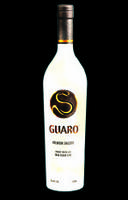 National pride can be wrapped up in so many things. Science, food, sports, music. And then there is the spirit world.
National pride can be wrapped up in so many things. Science, food, sports, music. And then there is the spirit world.Not the John Edward, talking-to-the-beyond-on-television kind of spirits, but the earthier ones found in amber bottles, cut-glass decanters and crystal tumblers.
Most countries point with pride to a "national drink." The French have champagne; the Greeks, ouzo; the Russians their vodka. They are not alone.
In the United Kingdom, for example, we readily find the single malts and gins of Scotland and England. Now even Wales, that forgotten little country that shares the British mainland with them, is getting back into the swing after being without a native distillery since 1894.
On March 1 this year, the 3-year-old Welsh Whisky Co. introduced its first product, Penderyn single-malt whiskey, created from barley malt and Welsh spring water. It retails for about $40.
The privately owned distillery, which operates in the Brecon Beacons National Park, revives a Welsh industry that had provided experienced whiskey makers who were among the founding fathers of the American bourbon industry. In Penderyn, the American link lives on. The whiskey is aged in Jack Daniels and Evan Williams bourbon casks shipped from the United States before being finished in Wales in rare Madeira barrels.
In the United States, we've long enjoyed "national" drinks brought to our shores from elsewhere in our hemisphere -- the rums of Jamaica and Puerto Rico, and the tequilas of Mexico, for example. Now, a trio of previously little-known alcohols from the Americas recently discovered by U.S. tourists is beginning to make inroads in our domestic market.
From Central America comes S Guaro, introduced in the United States just this year. It's made in Costa Rica from pure sugar cane with no additives.
Right now, S Guaro is essentially a California drink, with a marketing campaign by distributor S Spirits of Malibu that began by creating a word-of-mouth buzz by serving it at parties orbiting the Golden Globes, Grammy and Academy Awards shows.
The campaign is similar to one launched last year in the New York area by the distributor of Hpnotiq, a pale-blue French concoction of cognac, vodka and fruit juices. Movie premieres, nightclubs and celebrity parties in the city and in The Hamptons were successfully targeted, and the pale-blue drink quickly caught on.
"We're trying that grass-roots thing, too, before we try to go nationwide," said Shari F. Levanthal, marketing director for S Spirits. "Funny thing is that if you mix Hypnotiq and S Guaro, you get a great combination drink."
Guaro tastes more like a vodka than it does anything else, and its distributors recommend it as part of a mixed drink rather than straight.
On the Caribbean isle of St. Martin/Sint Maarten, the indigenous guavaberry that centuries ago was turned into liquor by the Amer-Indian people is today distilled into a unique "folk liqueur," even though the fragile berries are difficult to cultivate and harvest.
My first experience with guavaberry liqueur was a colada served in a Philipsburg hotel bar on the Dutch side of the island. It's a deceptively smooth drink, reminiscent of blackberries and dark cherries, sweet but not overly so, thanks to the slightly woody, spicy taste of the liquor.
Despite the name, the guavaberry (GWAH-va-BER-ry) has nothing to do with the guava fruit. The liqueur -- easily available online for $19.50 -- is made from oak-aged rum, cane sugar and the berries that grow wild in the warm hills in the center of the island.
Farther south, in Brazil, a form of brandy called cachaca (ka-CHASS-ah, Portuguese for firewater) has taken the South American nation by storm in the past few years. Odd that it took so long, considering it has been around since the 1500s.
Cachaca is distilled from unrefined sugar-cane juice fermented in a wood or copper container for three weeks, then boiled down three times to a concentrate, giving it a rumlike flavor. The more expensive versions are aged in wood casks that provide a caramel color and take the edge off the raw alcohol taste.
Brazil has some 4,000 brands of cachaca (Pirapora, Pitu and Velho Barreiro Gold among them, priced in the $24-to-$30 range), making it second only to beer among alcoholic drinks consumed there.
Like tequila, which moved from being a blue-collar drink to upscale status in Mexico and the United States in recent years, cachaca has taken the same path. It got an extra boost when bartenders at trendy tourist spots in the Brazilian metro areas of Rio de Janiero and Sao Paolo looking for something novel began using it as the basis for a line of cocktails.
The most popular is a simple one called the caipirinha. It's made by crushing slices of fresh lime in a glass, sprinkling sugar over them, filling the glass with chilled cachaca and popping in a few ice cubes.
Ah, what a hemisphere!
ON THE WEB
• Dowd's Guides
2 comments:
I strongly disagree with:
"Cachaca is distilled from unrefined sugar-cane juice fermented in a wood or copper container for three weeks, then boiled down three times to a concentrate, giving it a rumlike flavor."
This only applies to Industrial cachaca not the small batch stuff that is made in the traditional manner. True cachaca doe not have a rum like flavor because it has a very short (18-24 hour) fermentation time. It is also not boiled down 3 times. Cachaca made in the industrial manner is just cheap rum (made in Brazil) that is pretending to be cachaca.
Well, "Anonymous," you must know more about how the particular cachaca I sampled is made than does the person who makes it.
Nevertheless, this particular stuff is made precisely as I described it, and, in the view of the trio of people who atsted it with me, has the rumlike flavor I mention.
Post a Comment